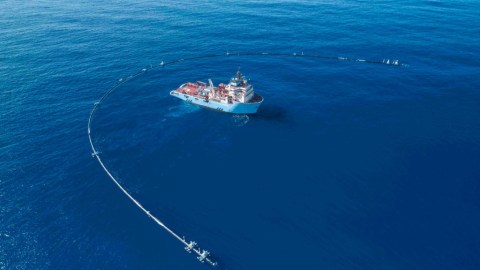Ocean Cleanup’s 2,000ft net deployed at Great Pacific Garbage Patch

The Ocean Cleanup Foundation
- The U-shaped System 001 is designed to collect massive amounts of garbage.
- A boat will come collect the garbage every couple of months.
- This is the first full-scale, real-world test of the foundation’s technology, which has been criticized by skeptics.
A 2,000-foot-long floating pipe connected to a submerged net arrived Tuesday at its destination in the Pacific Ocean where it will begin collecting massive amounts of plastic.
The system belongs to the Ocean Cleanup Foundation, a Dutch environmental startup that’s aiming to remove 90 percent of the Great Pacific Garbage Patch—the largest of the world’s five ocean trash patches—by 2040. In September, System 001 departed from San Francisco for the garbage patch, located about 1,000 miles off the coast of California.
Timelapse drone shot of System 001 during one of the re-orientation tests. If it performs well for the remaining tests, we will have another checklist item completed. pic.twitter.com/u630jEX2KZ
— The Ocean Cleanup (@TheOceanCleanup) September 20, 2018
System 001
System 001, nicknamed Wilson, is a giant U-shaped barricade that corrals trash and plastic with a 3-meter-deep net. The system is remotely controlled and outfitted with two cameras. A boat will come to collect the garbage every couple of months.
The foundation published a video detailing how it works.
Scaling up to save ocean life
The foundation, which has raised more than $30 million since 2013, hopes to eventually deploy a fleet of approximately 60 systems similar to Wilson.
“That plastic is still going to be there in one year. It’s still going to be there in ten years,” said 24-year-old Ocean Cleanup founder and CEO Boyan Slat. “It’s probably still going to be there in 100 years, so really only if we go out there and clean it up this amount of plastic is going to go down.”
Although some have criticized the foundation’s first-of-its-kind technology, Slat said the only way to know whether it’s effective is to test this first system at full scale.
“We’re confident we’ve eliminated risks where possible, but not everything can be calculated, simulated or tested at scale[4],” he said. “The only way to be sure is to trial it at full scale. Our first system should be regarded as a beta system, allowing us to eliminate the last remaining uncertainties before scaling up.”
The coming months will hopefully reveal just how effective System 001 really is, and whether it could help make a dent in the estimated 8 million metric tons of garbage that flow into the world’s ocean every year.





